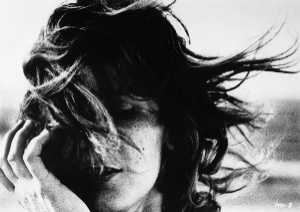 Vertigo (1958) is a film about a man who attempts to turn the clock back in pursuit of an image of a woman he loves. The Madeline he loves is not the Madeline who is Elster’s wife. Nor is she Judy, the woman who has been paid by Elster to act as his wife. The Madeline Scotty has fallen in love with is a fiction.
Vertigo (1958) is a film about a man who attempts to turn the clock back in pursuit of an image of a woman he loves. The Madeline he loves is not the Madeline who is Elster’s wife. Nor is she Judy, the woman who has been paid by Elster to act as his wife. The Madeline Scotty has fallen in love with is a fiction.
When he thinks she is dead he breaks down. When he recovers he sees Judy on the street. As he attempts to make her back into Madeline he is attempting to return to an impossible past. At the moment his vision is fully realised it is snatched away from him. Judy plummets to her death just as Madeline did before her.
Now, compare to La Jetée (1962). The protagonist of La Jetée lives in a post-apocalyptic Paris. He is sent into the past by evil experimenters. He is a better candidate for time travel than others because his memory is strongly marked by an image of his past, the image of a woman. He travels backwards in time and finds this woman. He makes several more trips back in time, and each time he meets her. They become friends, they fall in love.
 Finally the experimenters are satisfied he can cope with being sent to whichever point in time they choose. He is sent into the future to bring back a power plant which will save the human race. Once he has fulfilled this task he is returned to his prison cell. The virtuous people of the future come to him in his cell and offer to accept him as one of their own. He declines. He doesn’t want to live in the future. He wants to return to the past and the woman he loves. They oblige. He is returned to the moment he remembers so vividly. He has achieved his return to an impossible past, and at the moment of its consummation it is snatched away from him, just like it is taken from Scotty.
Finally the experimenters are satisfied he can cope with being sent to whichever point in time they choose. He is sent into the future to bring back a power plant which will save the human race. Once he has fulfilled this task he is returned to his prison cell. The virtuous people of the future come to him in his cell and offer to accept him as one of their own. He declines. He doesn’t want to live in the future. He wants to return to the past and the woman he loves. They oblige. He is returned to the moment he remembers so vividly. He has achieved his return to an impossible past, and at the moment of its consummation it is snatched away from him, just like it is taken from Scotty.
Aside from these parallels in the storyline there are visual clues. The hairstyle of the woman in La Jetée is sometimes the same as Madeline’s in Vertigo, but most importantly, there is a brief scene in La Jetée where the man points to a point beyond a sequioa tree stump to show the woman where in time he comes from. The shot of their hands is very similar to Judy/Madeline’s in Vertigo.
Marker drops clues in Sans Soleil and on his CD-ROM Immemory. From the script of Sans Soleil:
The small Victorian hotel where Madeline disappeared had disappeared itself; concrete had replaced it, at the corner of Eddy and Gough. On the other hand the sequoia cut was still in Muir Woods. On it Madeline traced the short distance between two of those concentric lines that measured the age of the tree and said, “Here I was born… and here I died.â€
He remembered another film in which this passage was quoted. The sequoia was the one in the Jardin des plantes in Paris, and the hand pointed to a place outside the tree, outside of time.
And now, writing about how San Francisco has changed since Vertigo was made in Immemory:
The Redwood round is still at the entry to Muir Woods on the other side of the bay, it has had more luck than its sister at the Jardin des Plantes, now relegated to a basement. (Vertigo could almost be shot in the same decors today, unlike its remake in Paris).
Terry Gilliam’s Twelve Monkeys is a remake of La Jetée, but that doesn’t mean it’s a re-remake of Vertigo. What Marker took from Hitchcock was the central relationship between the man and the woman and its exploration of the workings of memory and desire. What Gilliam took from Marker was the idea of sending people backwards and forwards in time to save the present. In fact, Gilliam didn’t develop the idea for Twelve Monkeys and he came to direct the film having never seen La Jetée. He watched it later. The screenwriters of Twelve Monkeys, it seems to me, missed the core of La Jetée – or maybe what they wanted to take from the film and make anew simply wasn’t what I think is vitally important about it.
